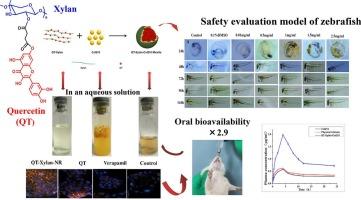槲皮素共轭木聚糖纳米胶束对P-gp的抑制作用及对不溶性药物辅酶Q10的口服生物利用度的提高
IF 6.3
2区 化学
Q1 POLYMER SCIENCE
引用次数: 0
摘要
本研究采用碳二亚胺反应设计合成了一种两亲性聚合物槲皮素−木聚糖(qt -木聚糖)载体,该载体能有效改善辅酶q10的水溶性,提高其口服生物利用度,抑制p -糖蛋白(P-gp)的药物排泄。荧光探针测定了qt -木聚糖的临界胶束浓度(CMC)为0.87 mg/mL。采用探针超声法和溶剂蒸发法对qt -木聚糖载体进行了辅酶q10的负载。经优化后,其载药量可达(11%±0.5)。利用1HNMR、FTIR等对qt -木聚糖和qt -木聚糖-辅酶q10进行了表征。在口服生物利用度研究中,qt -木聚糖辅酶q10在大鼠体内的曲线下面积(AUC)约为原辅酶q10的2.9倍。因此,qt -木聚糖作为一种新型口服难溶性药物的理想载体,在提高难溶性药物的溶解度,从而提高其口服生物利用度方面具有广泛的意义。本文章由计算机程序翻译,如有差异,请以英文原文为准。

Quercetin conjugated xylan nanomicelles with P-gp inhibition and enhancement of oral bioavailability of insoluble drug Coenzyme Q10
In this study, an amphiphilic polymer quercetin − xylan (QT-xylan) carrier was designed and synthesized using the carbodiimide reaction, which can effectively improve the water solubility of CoQ10, increase its oral bioavailability and inhibit the drug excretion of P-glycoprotein (P-gp). The critical micelle concentration (CMC) of QT-xylan was determined to be 0.87 mg/mL using fluorescent probes.The QT-xylan carrier was loaded with CoQ10 by means of probe ultrasonic method and solvent evaporation method. After optimization, its drug loading capacity can reach (11 %±0.5). QT-xylan and QT-xylan-CoQ10 were characterized using 1HNMR, FTIR,etc. In the study of oral bioavailability, the area under the curve (AUC) of QT-xylan-CoQ10 in rats was approximately 2.9 times that of the original CoQ10. Therefore, QT-xylan, as an ideal carrier for a new type of oral poorly soluble drug, has extensive significance in improving the solubility of poorly soluble drugs and thereby enhancing their oral bioavailability.
求助全文
通过发布文献求助,成功后即可免费获取论文全文。
去求助
来源期刊

European Polymer Journal
化学-高分子科学
CiteScore
9.90
自引率
10.00%
发文量
691
审稿时长
23 days
期刊介绍:
European Polymer Journal is dedicated to publishing work on fundamental and applied polymer chemistry and macromolecular materials. The journal covers all aspects of polymer synthesis, including polymerization mechanisms and chemical functional transformations, with a focus on novel polymers and the relationships between molecular structure and polymer properties. In addition, we welcome submissions on bio-based or renewable polymers, stimuli-responsive systems and polymer bio-hybrids. European Polymer Journal also publishes research on the biomedical application of polymers, including drug delivery and regenerative medicine. The main scope is covered but not limited to the following core research areas:
Polymer synthesis and functionalization
• Novel synthetic routes for polymerization, functional modification, controlled/living polymerization and precision polymers.
Stimuli-responsive polymers
• Including shape memory and self-healing polymers.
Supramolecular polymers and self-assembly
• Molecular recognition and higher order polymer structures.
Renewable and sustainable polymers
• Bio-based, biodegradable and anti-microbial polymers and polymeric bio-nanocomposites.
Polymers at interfaces and surfaces
• Chemistry and engineering of surfaces with biological relevance, including patterning, antifouling polymers and polymers for membrane applications.
Biomedical applications and nanomedicine
• Polymers for regenerative medicine, drug delivery molecular release and gene therapy
The scope of European Polymer Journal no longer includes Polymer Physics.
 求助内容:
求助内容: 应助结果提醒方式:
应助结果提醒方式:


